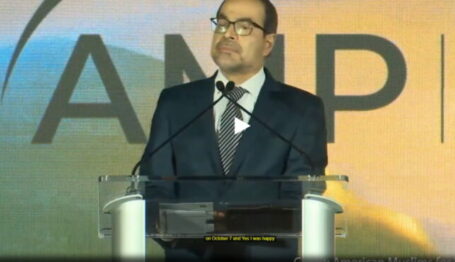Foundation Watch
The Gates Foundation Funding of the Second Green Revolution


The Bill and Melinda Gates Foundation has spent billions funding a “second Green Revolution,” which is appearing to have devastating effects. The foundation funds groups like the Alliance for a Green Revolution to impose on African farmers technology that is associated with those that enrich large corporations like Monsanto.
The Gates Foundation created the Alliance for a Green Revolution in Africa (AGRA) with the Rockefeller Foundation in 2006. From 2006 to 2020, AGRA received about $1 billion in funding, two-thirds of which was from the Gates Foundation, and it gave out over $500 million in grants across 13 African countries. AGRA was created to initiate this second Green Revolution in the name of reducing hunger.
The Green Revolution the Gates Foundation refers to is the period between the 1940s and 1960s when the mass commercialization of pesticides, fertilizers, and hybrid seeds through genetic modification took over agriculture production worldwide.
Consequences of the Second Green Revolution
The commercialization of the agriculture industry through a second Green Revolution has been promoted by Bill Gates and large corporations for the supposed purpose of lowering the cost of food production and combating climate change. However, the second Green Revolution has been criticized for allowing corporations to monopolize on the genetically modified crops, increase energy consumption and emissions, create larger barriers to entry for smaller farmers, and decrease the nutritional value of the harvested food.
The best example of the consequences of the second Green Revolution is the influence Monsanto has gained over agricultural law and the industry without regard to the health of consumers. Monsanto has exploited regulations and patent laws to maintain a monopoly on seeds and the technologies introduced by the Green Revolution.
Environmental activists such as Vandana Shiva have openly criticized Bill Gates and other billionaires for funding the second Green Revolution, claiming he intends to join Monsanto in monopolizing the agriculture industry by expanding the novel practices globally while increasing malnourishment and poverty. Additionally, numerous native African farmer and activist organizations campaign against the philanthropic efforts to impose the Green Revolution on Africa. One activist likened the American influence over Africa’s food systems to police brutality in the American justice system.
Funding the Second Green Revolution
Despite these criticisms, the Gates Foundation has made the funding of the new Green Revolution a top priority. The Gates Foundation’s 2018 public tax returns show that it spent over $415 million dollars on grants to other organizations for “Agricultural Development,” which is consistent with previous years’ spending totals. AGRA is the largest grantee, having received $35 million. Other top Agricultural Development grantees include:
- $27,679,275 to Centro Internacional de Mejoramiento de Maiz y Trigo
- $17,228,268 to Cornell University
- $14,854,877 to International Crops Research Institute for the Semi-Arid Tropics
- $14,497,453 to International Rice Research Institute
- $13,758,710 to International Bank for Reconstruction and Development
- $13,468,290 To University of Greenwich
- $13,201,328 to International Institute of Tropical Agriculture
- $$11,824,397 to African Agricultural Technology Foundation
Out of the Gates Foundation’s top nine agricultural grants, totaling over $150 million, all but the one to the University of Greenwich were for promoting GMO seed development and integration.
Impact of Funding the Green Revolution
AGRA’s method for reducing poverty and increasing food production in Africa is to provide grants for smallholder farmers to use hybrid seeds and other practices associated with the Green Revolution. It also lobbies governments to promote these farming practices in hopes that they become the standard in African countries.
AGRA set various goals for increasing food production and reducing poverty by 2020, which it did not report on after hitting the deadline, but a study performed by Tufts University researchers analyzed AGRA’s impact on the regions it operates in. They found:
- A 30 percent increase in hunger in the 13 countries in which AGRA operates.
- Despite a goal of doubling productivity, AGRA countries averaged an 18 percent increase in staple crop yield.
- Nine out of AGRA’s 13 countries saw an increase in hunger levels.
The study reports that mid-scale farmers benefited more than smallholders, but both faced difficulties affording the fertilizers and technologies needed to maximize the production with the hybrid seeds. The study explains that the funding and subsidies allow farmers to plant at higher rates, but they could not produce at a comparable level because their operating costs were too high. This strongly suggests that the Green Revolution technology would tend to benefit only larger corporations, which can take advantage of their economies of scale.
Big Tech’s Influence over Agriculture
The Gates Foundation has spent billions of dollars under the pretense of charitable giving to influence food systems all over the world in order to make them more dependent on seed technology that is owned by large corporations like Monsanto. Curiously, the Gates Foundation has also invested over $23 million in Monsanto and hired Sam Dryden, the former CEO of Emergent Genetics, a seed development company that was purchased by Monsanto in 2005.
In addition to the Gates Foundation’s financial connections to agriculture companies like Monsanto, Bill Gates has become the largest farmland owner in the United States—and other tech billionaires have followed suit. In response to being questioned about his ownership of farmland, Gates merely said, “The agriculture sector is important. With more productive seeds we can avoid deforestation and help Africa deal with the climate difficulty they already face.”
The only apparent positive impact of the second Green Revolution is that it benefits the large corporations who own the technology—to the detriment of food production for impoverished people and farmers.



